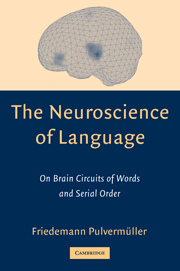Book contents
- Frontmatter
- Contents
- Preface
- The Neuroscience of Language
- 1 A Guide to the Book
- 2 Neuronal Structure and Function
- 3 From Classic Aphasia Research to Modern Neuroimaging
- 4 Words in the Brain
- Excursus E1 Explaining Neuropsychological Double Dissociations
- 5 Regulation, Overlap, and Web Tails
- 6 Neural Algorithms and Neural Networks
- 7 Basic Syntax
- 8 Synfire Chains as the Basis of Serial Order in the Brain
- 9 Sequence Detectors
- 10 Neuronal Grammar
- 11 Neuronal Grammar and Algorithms
- Excursus E2 Basic Bits of Neuronal Grammar
- Excursus E3 A Web Response to a Sentence
- 12 Refining Neuronal Grammar
- Excursus E4 Multiple Reverberation for Resolving Lexical Ambiguity
- Excursus E5 Multiple Reverberations and Multiple Center Embeddings
- 13 Neurophysiology of Syntax
- 14 Linguistics and the Brain
- References
- Abbreviations
- Author Index
- Subject Index
Excursus E5 - Multiple Reverberations and Multiple Center Embeddings
Published online by Cambridge University Press: 15 December 2009
- Frontmatter
- Contents
- Preface
- The Neuroscience of Language
- 1 A Guide to the Book
- 2 Neuronal Structure and Function
- 3 From Classic Aphasia Research to Modern Neuroimaging
- 4 Words in the Brain
- Excursus E1 Explaining Neuropsychological Double Dissociations
- 5 Regulation, Overlap, and Web Tails
- 6 Neural Algorithms and Neural Networks
- 7 Basic Syntax
- 8 Synfire Chains as the Basis of Serial Order in the Brain
- 9 Sequence Detectors
- 10 Neuronal Grammar
- 11 Neuronal Grammar and Algorithms
- Excursus E2 Basic Bits of Neuronal Grammar
- Excursus E3 A Web Response to a Sentence
- 12 Refining Neuronal Grammar
- Excursus E4 Multiple Reverberation for Resolving Lexical Ambiguity
- Excursus E5 Multiple Reverberations and Multiple Center Embeddings
- 13 Neurophysiology of Syntax
- 14 Linguistics and the Brain
- References
- Abbreviations
- Author Index
- Subject Index
Summary
This excursus presents and discusses a very complex sentence, which is actually a word chain whose status as a grammatical sentence may be questioned. The interested reader may nevertheless find it relevant to glance at the processes, because of the prominent role sentences of this type played in the history of language science. The present circuit proves that a string with center embeddings can be processed by neuronal grammar. There is nothing in the neuronal algorithm that would restrict the number of embeddings possible. Clearly, however, such restrictions apply for biological systems.
Consider sentence (1).
(1) Betty who John who Peter helps loves gets up.
Figure E5.1 presents the network representations of the elements of this sentence, word webs and sequence sets, and their mutual connections, whereas Table E5.1 shows the derivation. It becomes obvious from the table that this derivation draws heavily on multiple activation of sequence sets. As in Excursus E4, the table lists multiple activity states of each neuronal set at each time step, with the highest activity state listed at the top. Note that, according to the present proposal, each neuronal set can be considered a store in which multiple entries can be placed on each other. A similar proposal was made by Schnelle (1996b). The little “stacks” of symbols represent the entries in the pushdown memory characterizing each set. The maximum “height” of a stack is three levels.
Information
- Type
- Chapter
- Information
- The Neuroscience of LanguageOn Brain Circuits of Words and Serial Order, pp. 255 - 264Publisher: Cambridge University PressPrint publication year: 2003
